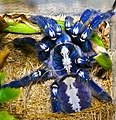华丽雨林属
| 华丽雨林属 | |
|---|---|

| |
| 沙連華麗雨林 Poecilotheria formosa | |
| 科学分类 | |
| 界: | 动物界 Animalia |
| 门: | 节肢动物门 Arthropoda |
| 纲: | 蛛形纲 Arachnida |
| 目: | 蜘蛛目 Araneae |
| 科: | 捕鳥蛛科 Theraphosidae |
| 属: | 华丽雨林属 Poecilotheria Simon, 1885[1] |
| 模式種 | |
| Poecilotheria fasciata | |
| 種 | |
|
16,見內文 | |
華麗雨林屬(學名:Poecilotheria),是原产于印度和斯里兰卡的一屬捕鳥蛛。它是由歐仁·西蒙在1885年首次描述。[2] 它们是树栖狼蛛,通常被称为观赏狼蛛,与其他狼蛛相比,它们以生动的色彩模式、快速的运动和强烈的毒液而闻名。截至2019年,所有物种都受到CITES的保护。
该属的名称是由古希腊语的组合。"poikilos" (ποικίλος),意思是 "有斑点",和therion" (θηρίον),意思是 "野生野兽"。
分類學
[编辑]属于Poecilotheria的物种是由荷兰动物学家艾爾伯特·瑟巴在1734年首次记录的,当时他去了斯里兰卡。他将他看到的新蜘蛛以 "Aranea maxima ceilonica"(意思是 "来自斯里兰卡的大蜘蛛")的名字发表在他的《Albertus Seba's Thesaurus》一书的插图中。然而,最精确的科学解释出现在1804年,当时皮埃爾·安德烈·拉特雷耶将这种蜘蛛描述为 "Mygale fasciata"。[3][4]
经过大约40年的延迟,在1850年,C.L. Koch将Mygale的属名修改为Scurria,物种则为Scurria fasciata。1885年,歐仁·西蒙提议用Poecilotheria代替Scurria,因为对软体动物的物种描述错误。[3]
对一些物种的分类学有争议。一些资料将斯里兰卡的彼德遜華麗雨林(Poecilotheria vittata)认定为印度的(Poecilotheria striata)的异名,但在其他资料中,它们都被赋予有效的物种身份。[1] 斯里兰卡的Poecilotheria bara的命名也存在争议--它是否与发现于斯里兰卡中南部的象牙華麗雨林(Poecilotheria subfusca)是同一个物种。2014年,斯里兰卡蜘蛛学家拉尼爾·P·納納亞克拉(Ranil P. Nanayakkara)将 "P. vittata"、"P. striata"、"P. bara "和 "P. subfusca "视为不同物种。[3]
2019年,斯里兰卡蜘蛛学家拉尼爾·P·納納亞克拉於其國內的薩伯勒格穆沃省找到另一種華麗雨林,即Poecilotheria srilankensis,另本屬物種共計有16種[5]
物種
[编辑]截至2019年,世界蜘蛛目录接受以下物种,7个来自印度,7个来自斯里兰卡,2个来自两个国家。[1]
印度
[编辑]- 沙連華麗雨林 Poecilotheria formosa Pocock, 1899
- 藍寶石華麗雨林 Poecilotheria metallica Pocock, 1899
- 米蘭達華麗雨林 Poecilotheria miranda Pocock, 1900
- 印度華麗雨林 Poecilotheria regalis Pocock, 1899
- 石板紅華麗雨林 Poecilotheria rufilata Pocock, 1899
- 邁索爾華麗雨林 Poecilotheria striata Pocock, 1895
- 衛索華麗雨林 Poecilotheria tigrinawesseli Smith, 2006
斯里兰卡
[编辑]- 斯里蘭卡華麗雨林 Poecilotheria fasciata (Latreille, 1804) (模式種)
- 花邊華麗雨林 Poecilotheria ornata Pocock, 1899
- Poecilotheria rajaei Nanayakkara, et al., 2012
- 史密斯華麗雨林 Poecilotheria smithi Kirk, 1996
- 象牙華麗雨林 Poecilotheria subfusca Pocock, 1895
- Poecilotheria srilankensis Nanayakkara, et al., 2020
兩個國家均有
[编辑]- 拉馬納塔普蘭華麗雨林 Poecilotheria hanumavilasumica Smith, 2004
- 彼德遜華麗雨林 Poecilotheria vittata Pocock, 1895
初级同义词
[编辑]以下物种曾经被认为是种,但截至2016年2月,现在被世界蜘蛛目录认为是其他物种的同义词[1]
- Poecilotheria amarasekarai = P. rajaei;[3]被其他来源认为是不同的[6]
- Poecilotheria bara Chamberlin, 1917 = P. subfusca;被其他来源认为是不同的[3]
- Poecilotheria gadgili Tikader, 1977 = P. regalis
- Poecilotheria nallamalaiensis Rao et al., 2006 = P. formosa
- Poecilotheria pederseni Kirk, 2001 = P. vittata
- Poecilotheria pococki Charpentier, 1996 = P. smithi
- Poecilotheria uniformis Strand, 1913 = P. subfusca
生物學
[编辑]本屬的物种很容易与捕鳥蛛科的其他物种区分开来,因为其扁平的背甲,顎有刺,以及像小瘤的黑色牙齿。它们的腿上没有刺,腿上的步足毛束可以清楚地看到。腹面有独特的颜色图案,特别是在腿上。在腹部的背面有几条斑斓的条纹和黑白相间的斑点。第一和第四对腿上有醒目的黄色和黑色的图案,这个特征特别用于识别到物种水平。
雄性和雌性显示出性二形性,这使其易于识别。成熟的雄性很容易被称为儲精囊的高度硬化的精子储存袋所识别。掌球用于将精子注入雌性的生殖器中。雄性比雌性小,身材也更苗条。在雄性中,第一对和第四对腿的长度相同,但在雌性中,第一对腿比第四对长。雄性通常颜色比较暗淡,有隐性标记,不显眼。然而,光脑上的对开标记比雌性的要深。[3]
生態學
[编辑]本屬的物种是夜间和夜间的猎手。它们在黄昏和黎明时分出来觅食。与许多其他蜘蛛不同,它们不使用蜘蛛网来捕捉猎物。相反,它们是埋伏的捕食者,它们坐在那里等待,直到猎物走近或经过,然后以极快的速度跟踪猎物,抓住它,并注入毒液,使其不能动弹。
一旦猎物被抓住,它们就用丝卷住猎物并开始进食。虎头蜘蛛最常见的猎物是昆虫、幼虫、小鸟和小型哺乳动物如蝙蝠,甚至是其他蜘蛛和同种的雄性蜘蛛(由雌性)。
有几个本屬的物种被列为 「濒危」或「极度濒危」,主要威胁是栖息地的丧失及被收集和走私用于宠物贸易,藍寶石華麗雨林 (P. metallica)及拉馬納塔普蘭華麗雨林(P. hanumavilasumica)均被列為极度濒危。[7][8]
保育現狀
[编辑]截至2019年,華麗雨林屬的所有物种都被列入CITES附录II內。这意味着,如果没有出口国的CITES出口许可证,标本不能合法交易(国际)(如果标本以前从其他国家进口过,则需要CITES再出口许可证)。[9]
相片
[编辑]-
象牙華麗雨林 Poecilotheria subfusca.
-
藍寶石華麗雨林 Poecilotheria metallica
-
印度華麗雨林 Poecilotheria regalis
-
石板紅華麗雨林 Poecilotheria rufilata
-
Poecilotheria rajaei
參考文獻
[编辑]- ^ 1.0 1.1 1.2 1.3 1.4 Gen. Poecilotheria Simon, 1885. World Spider Catalog. Natural History Museum Bern. [2016-02-28]. (原始内容存档于2023-06-24).
- ^ Simon, E. Matériaux pour servir à la faune arachnologiques de l'Asie méridionale. I. Arachnides recueillis à Wagra-Karoor près Gundacul, district de Bellary par M. M. Chaper. II. Arachnides recueillis à Ramnad, district de Madura par M. l'abbé Fabre. Bulletin de la Société Zoologique de France. 1885, 10: 1–39.
- ^ 3.0 3.1 3.2 3.3 3.4 3.5 Nanayakkara, Ranil P. Tiger Spiders Poecilotheria of Sri Lanka. Colombo: Biodiversity Secretariat, Ministry of Environmental & Renewable Energy. 2014: 167. ISBN 978-955-0033-58-4.
- ^ Samarawickrama, V.A.M.P.K.; Jayananda, M.D.B.G.; Ranawana, K.B. & Smith, Andrew. Study of the distribution of the genus Poecilotheria in Sri Lanka. Ceylon Journal of Science: 75–86. [13 March 2016].
- ^ RANIL P. NANAYAKKARA. POECILOTHERIA SRILANKENSIS. [2023-06-23]. (原始内容存档于2023-06-23).
- ^ Perera, Palinda; Burt, Peter; Amarasekera, H.S. & Wattavidanage, Jayantha. Distribution, ecology and morphology of a newly discovered Poecilotheria species of Sri Lanka (Araneae - Theraphosidae). Proceedings of 17th International Forestry and Environment Symposium. 2012, 17: 13 [2016-02-26]. (原始内容存档于2023-06-23).
- ^ Search for Poecilotheria. IUCN Red List 3.1. [12 November 2018]. (原始内容存档于2018-11-12).
- ^ Molur, S.; Daniel, B.A. & Siliwal, M., Poecilotheria metallica, The IUCN Red List of Threatened Species, 2008 [2023-06-23], doi:10.2305/IUCN.UK.2008.RLTS.T63563A12681959.en, (原始内容存档于2022-10-06)
- ^ Updates on decisions made on proposals to amend Appendices I and II at CoP18: Decisions made on proposals to amend Appendices I and II. CITES. [28 August 2019]. (原始内容存档于2023-06-23).





